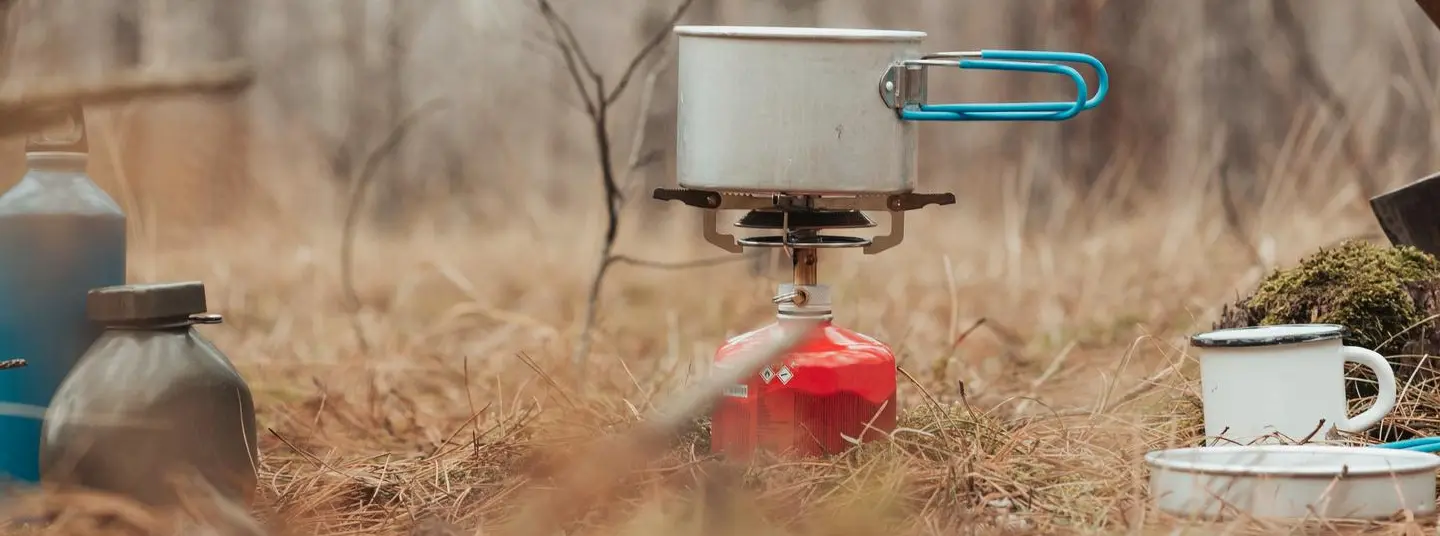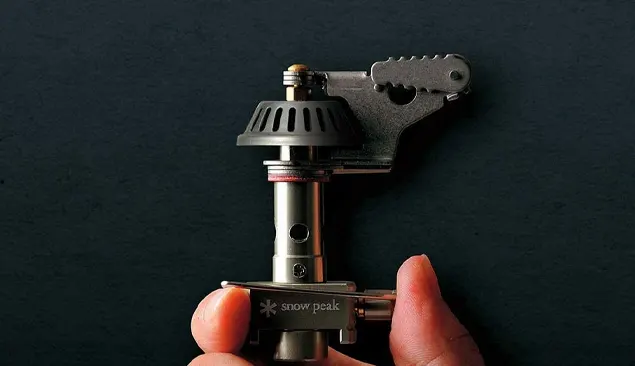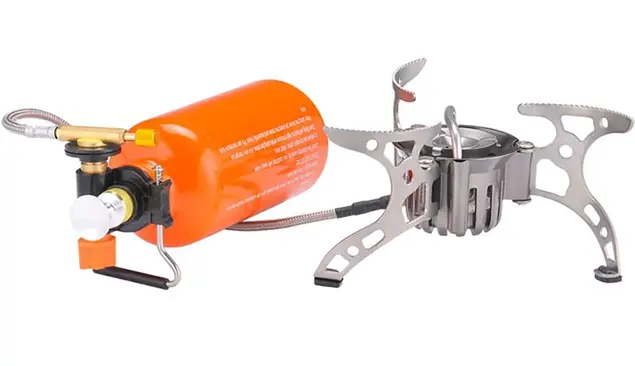

The guide on portable camp stoves delves into the various types available—canister, liquid fuel, alcohol burning, wood burning, and solid fuel stoves—each with unique pros and cons. Canister stoves are praised for their lightweight and ease of use but may falter in cold conditions. Liquid fuel stoves excel in freezing temperatures and for large groups, though they’re heavier and require more maintenance. Alcohol and solid fuel stoves offer simplicity and are budget-friendly, yet they have slower cooking times and may necessitate carrying extra fuel. Choosing the right stove depends on factors like fuel availability, cooking needs, and weight preferences.
Portable camp stoves are essential outdoor cooking equipment for campers who want to enjoy a delicious meal while exploring nature. Whether you’re embarking on a weekend camping trip or a long backpacking adventure, having a reliable camp stove can make all the difference in your cooking experience. In this article, we will explore the different types of portable camp stoves available in the market and discuss their pros and cons. So, let’s dive in and find the perfect camping stove for your outdoor adventures!
Key Takeaways:
- Portable camp stoves come in various types, including canister stoves, liquid fuel stoves, alcohol burning stoves, wood burning stoves, and solid fuel stoves.
- Canister stoves are lightweight and compact but may not function optimally in extreme cold conditions.
- Liquid fuel stoves are suitable for cooking for large groups and perform well in freezing temperatures, but they require more maintenance and are heavier.
- Alcohol burning stoves offer affordability and lightweight design but have slower cooking times and require carrying sufficient fuel due to quick burn rate.
- Wood burning stoves are environmentally friendly and don’t require carrying fuel, but they require effort to gather fuel and don’t perform well in bad weather.
Types of Portable Camp Stoves
There are several types of portable camp stoves to choose from, each with its unique characteristics and suitability for different camping scenarios. Whether you’re a solo backpacker or planning a group camping trip, understanding the different types of camp stoves can help you make the right choice. Let’s explore the various options available:
1. Canister Stoves
Canister stoves are a popular choice among campers due to their lightweight and compact design. They are easy to use and require minimal setup, making them ideal for hikers and backpackers. These stoves use pre-pressurized fuel canisters that are easily attachable and provide consistent heat. However, it’s important to note that canister stoves may struggle to perform in extreme cold conditions.
2. Liquid Fuel Stoves
For those planning to cook for large groups or camp in freezing temperatures, liquid fuel stoves are a reliable option. These stoves use liquid fuels like white gas, kerosene, or diesel, which offer excellent performance in cold weather. They provide a high heat output, making them ideal for cooking for larger groups. However, liquid fuel stoves are generally heavier than other types and require regular maintenance to keep them in optimal condition.
3. Alcohol Burning Stoves
If you’re looking for an affordable and lightweight option, alcohol burning stoves are worth considering. These stoves use denatured alcohol or other alcohol-based fuels, making them readily available and cost-effective. However, they have slower cooking times compared to other stove types and burn fuel quickly, requiring you to carry sufficient fuel for longer trips.
4. Solid Fuel Stoves
If you’re looking for a compact and easy-to-use option, solid fuel stoves are a good choice. These stoves use solid fuel tablets or cubes that burn cleanly and do not produce much smoke. They are lightweight and easy to transport, making them suitable for backpacking trips. However, solid fuel stoves have slower cooking times compared to other types and can be more expensive in the long run due to the cost of fuel tablets.
When choosing a portable camp stove, it’s important to consider factors like fuel availability, cooking time, and weight. Assessing your camping needs and preferences will help you select the stove that best suits your requirements. Remember, each type of stove has its pros and cons, so it’s essential to make an informed decision to enhance your camping experience.

Canister stoves provide an excellent balance of portability
Canister stoves are popular among campers due to their lightweight and compact design, making them easy to carry and set up in any camping kitchen. These portable gas stoves are a convenient choice for backpackers and hikers, as they take up minimal space in a backpack and are quick to assemble. With their efficient fuel canisters, they provide a reliable heat source for cooking meals on the go.
One of the key advantages of canister stoves is their simplicity. They typically have a straightforward ignition system and adjustable flame control, allowing campers to easily regulate the heat for precise cooking. Whether you’re boiling water for a hot cup of coffee or simmering a delicious backcountry meal, canister stoves deliver consistent performance.
While canister stoves offer many benefits, it’s important to consider their limitations. Extreme cold temperatures can affect the fuel’s performance, causing reduced heat output or even failure to light. This makes them less suitable for winter camping or high-altitude expeditions. However, for most camping adventures in moderate weather conditions, canister stoves prove to be a reliable and convenient cooking companion.

Overall, canister stoves provide an excellent balance of portability, functionality, and ease of use. Their lightweight and compact design make them a top choice for campers who prioritize efficiency and simplicity while enjoying the great outdoors. With proper care and fuel management, canister stoves can enhance your camping experience, allowing you to savor delicious meals wherever your adventures take you.
Liquid Fuel Stoves – Reliable Cooking for Large Groups
If you’re camping with a large group or in freezing temperatures, a liquid fuel stove can be a reliable choice for your camping kitchen. These stoves are designed to handle the demands of cooking for multiple people and perform well even in extreme weather conditions. With their powerful burners and efficient fuel consumption, they ensure that you can prepare meals quickly and efficiently, no matter the size of your camping party.
Liquid fuel stoves are known for their durability and reliability, making them a popular choice among avid campers and outdoor enthusiasts. Their ability to generate high heat output makes them ideal for boiling water, simmering soups, or cooking hearty meals. They can even handle heavy-duty cookware, allowing you to prepare a variety of dishes without any hassle.
Advantages of Liquid Fuel Stoves:
- Excellent performance in freezing temperatures
- Ability to cook for large groups
- Durable and reliable
- High heat output
- Compatible with heavy-duty cookware
However, it’s important to note that liquid fuel stoves do come with some trade-offs. Due to their construction and the need to carry fuel bottles, they tend to be heavier than other types of portable camp stoves. Additionally, they require regular maintenance, such as cleaning and priming, to ensure optimal performance. Despite these drawbacks, the benefits of using a liquid fuel stove often outweigh the inconveniences, especially when camping with a large group or in cold weather conditions.

| Pros | Cons |
|---|---|
| Reliable cooking for large groups | Heavier than other types of stoves |
| Excellent performance in freezing temperatures | Regular maintenance required |
| Durable and reliable | |
| High heat output | |
| Compatible with heavy-duty cookware |
Alcohol Burning Stoves – Cheap and Lightweight
For campers on a budget or those looking to minimize their camping gear weight, alcohol burning stoves offer a cost-effective and lightweight option for cooking on the go. These stoves are designed to burn denatured alcohol or methylated spirits as fuel, making them readily available and economical.
While alcohol burning stoves may not provide the fastest cooking times, they compensate for it with their affordability and portability. They are compact and lightweight, making them easy to carry in your backpack or camping kit without adding much weight.
In terms of simplicity, alcohol burning stoves are a breeze to use. They typically consist of a burner and a small pot stand, which can be easily set up and ignited. The flame produced is adjustable, allowing for precise heat control while cooking.
However, it’s important to note that alcohol burning stoves have slower cooking times compared to other types of portable camp stoves. They require more patience when preparing meals, especially if you are cooking for larger groups. Additionally, alcohol burns quickly, so it’s necessary to carry sufficient fuel for your cooking needs.
Advantages of Alcohol Burning Stoves:
- Cost-effective option for campers on a budget
- Lightweight and portable
- Simple and easy to use
Disadvantages of Alcohol Burning Stoves:
- Slower cooking times
- Quick burn rate requires carrying sufficient fuel

| Pros | Cons |
|---|---|
| Cost-effective | Slower cooking times |
| Lightweight and portable | Quick burn rate |
| Simple and easy to use | Require carrying sufficient fuel |
Solid Fuel Stoves – Compact and Easy to Use but Slow Cooking
When it comes to convenience and ease of use, solid fuel stoves offer a compact and hassle-free solution for your outdoor cooking needs. These lightweight camp stoves are designed to be portable and efficient, making them a popular choice among campers and backpackers. Solid fuel stoves are compact and easy to set up, making them ideal for those who value simplicity and efficiency in their camping gear.
One of the key advantages of solid fuel stoves is their compactness. These stoves are typically small in size and can easily fit into your backpack without taking up much space. This makes them a great option for hikers and backpackers who need to keep their gear lightweight and portable. Solid fuel stoves are also easy to use, with simple ignition systems that require minimal effort to start cooking.
However, it’s important to note that solid fuel stoves have slower cooking times compared to other types of camp stoves. The solid fuel tablets used as fuel burn at a slower rate, resulting in longer cooking times. This can be a drawback for those who require quick and efficient cooking when out in the wilderness. Additionally, the slow burn rate of solid fuel tablets can make these stoves more expensive in the long run, as you may need to carry a sufficient amount of fuel for extended trips.
| Pros | Cons |
|---|---|
| Compact and lightweight | Slower cooking times |
| Easy to use and set up | Potentially higher fuel costs |
Despite these limitations, solid fuel stoves can still be a reliable option for outdoor cooking, especially if you prioritize compactness and simplicity. By considering your specific needs and preferences, you can make an informed decision on whether a solid fuel stove is the right choice for your camping adventures.

Solid fuel stoves offer a compact and lightweight solution for outdoor cooking. Although they have slower cooking times and potential cost implications, these stoves are easy to use and convenient for those seeking simplicity in their camping gear.
Conclusion
Choosing the right portable camp stove is crucial for a successful camping trip, and understanding the pros and cons of each type can help you make an informed decision. Portable camp stoves come in various types, including canister stoves, liquid fuel stoves, alcohol burning stoves, wood burning stoves, and solid fuel stoves.
Canister stoves are lightweight and compact, making them easy to carry during backpacking trips. However, they may not work efficiently in extreme cold conditions. On the other hand, liquid fuel stoves are a reliable option for cooking for large groups and can perform well in freezing temperatures. However, they tend to be heavier and require regular maintenance.
If you’re looking for an affordable and lightweight option, alcohol burning stoves are a good choice. They are easy to use and don’t weigh you down, but keep in mind that they have slower cooking times and burn fuel quickly, so you need to carry sufficient fuel.
Lastly, solid fuel stoves are compact, easy to use, and can be a convenient choice. However, they have slower cooking times and can be more expensive due to the cost of fuel tablets. When making your decision, consider factors such as fuel availability, cooking time, and weight to find the portable camp stove that best suits your needs.
FAQ
Q: What types of portable camp stoves are available?
A: Portable camp stoves come in different types, including canister stoves, liquid fuel stoves, alcohol burning stoves, wood burning stoves, and solid fuel stoves.
Q: What are the pros and cons of canister stoves?
A: Canister stoves are lightweight, compact, and easy to use. However, they may not work well in extreme cold conditions.
Q: What are the advantages and disadvantages of liquid fuel stoves?
A: Liquid fuel stoves are good for cooking for large groups and perform well in freezing conditions. However, they are heavier and require more maintenance.
Q: Are alcohol burning stoves a good option?
A: Alcohol burning stoves are cheap and lightweight. However, they have slower cooking times and burn fuel quickly, requiring the carrying of sufficient fuel.
Q: What are the advantages and disadvantages of solid fuel stoves?
A: Solid fuel stoves are compact and easy to use. However, they have slow cooking times and can be expensive due to the cost of solid fuel tablets.
Tom is a seasoned camper and outdoor adventurer, with decades of experience exploring the wilderness. He's a retired park warden and has spent his life studying the flora and fauna of the natural world. Tom is a skilled outdoorsman, with a particular interest in backcountry camping, mountaineering, and wilderness survival. He's also an accomplished writer and has published several books on outdoor recreation.Author

Tom Miller
Recent Posts


